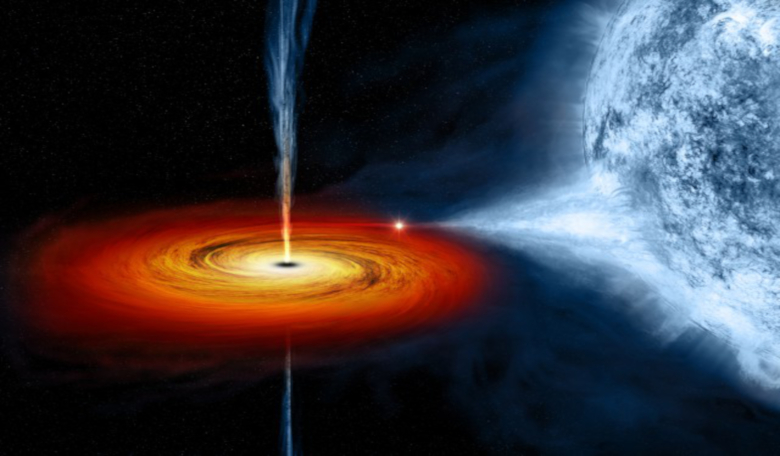A team of Japanese scientists using MAXI (The Monitor of All-sky X-ray Image), an instrument attached to the International Space Station, has found what could be the most massive black hole among the known black hole binaries in our Galaxy.
Black hole binaries (BHBs), are systems consisting of a stellar mass black hole and a star. These are not to be confused with BBHs (binary black holes) which are two black holes in close orbit around each other. These are the type that allowed scientists to detect theorised gravitational waves predicted by Einstein over a century ago when two were spotted merging together.
Stellar mass black holes form from the remnants of a large star that dies in a supernova explosion and considering the number of stars in our galaxy (as many as 200 billion stars or perhaps more have been suggested), scientists estimate that the Milky Way contains a staggering few hundred million black holes of this type.
However despite their numbers, finding them is incredible difficult because most stellar black holes live alone and as they don’t emit any light, they generally go undetected.
Stellar black holes in close binary systems on the other hand can be observed when matter is transferred from a companion star and subsequently gobbled up by its unseen carnivorous partner.
When this happens a stream of X-rays is emitted which lights up the odd couple like a beacon, but predicting when this might happen is impossible.
Instead, astronomers rely on instruments to continually sweep the skies looking for transient signals that could the point the way to a BHB.
MAXI is designed to do just that. Built by Japan, MAXI surveys around 85 percent of the sky approximately every 92 minutes looking for two distinct types of X-ray signals; one called a “low/hard” state and the other, a “high/soft” state.
A low/hard state is observed when the mass accretion rate by a black hole is relatively low and it changes to a “high/soft” state when the accretion rate becomes higher and the properties of the black hole change.
Since 2009, MAXI has discovered 13 new black hole binary transients by observing these types of signals, and now it has helped discover another new one; MAXI J1348−630.
MAXI J1348−630 was first discovered on 26 January, 2019 and was continually monitored for a further 176 days after being found.
The X-rays emanating from MAXI J1348−630 were also picked up by other telescopes able to detect high energy radiation, including ESA's INTErnational Gamma-Ray Astrophysics Laboratory, NASA’s Swift observatory and their Neutron star Interior Composition Explorer (NICER) – another instrument attached to the International Space Station (ISS), but this time devoted to the study of neutron stars.
After detecting the signal from MAXI J1348−630, the team behind the discovery, headed by Mayu Tominaga from Japan’s Aerospace Exploration Agency (JAXA), set about pinpointing where the BHB was hiding, in order to calculate its distance and its mass.
Using the peak luminosity properties of the emitted X-rays, compared with those from other established black hole binaries with known masses and distances, and taking into account the galactic coordinate of the source, Tominaga and colleagues determined that MAXI J1348−630 is located at a distance of between 4 to 8 kiloparsecs (kpc) away in the Galactic Scutum-Centaurus arm; one of the two major spiral arms in the Milky Way. The Scutum-Centaurus arm passes between us and the galactic center, and extends to the other side of the galaxy. A kiloparsec is 1000 parsecs and one parsec is approximately 3.26 light-years.
From the distance, the researchers were then able to constrain the mass of the black hole, which they specify would equate to around 16 solar masses at a distance of around 6 kpc.
This would make MAXI J1348−630, “the most massive black hole among the known black holes in our Galaxy,” write Tominaga and colleagues in their research paper, which can be found on the pre-print arxiv database, meaning it has yet to be peer-reviewed by other scientists.
It would even outweigh the heaviest of the stellar black holes so far known in the Milky Way Galaxy, GRS 1915+105, which is thought to be around 12 times the mass of the Sun.
Furthermore, if the black hole is spinning or the disk is inclined, the black hole mass will become still larger.
The existence of such massive black holes has been confirmed via gravitational wave detections due to black hole merger, but they have never been observed as X-ray binaries note the team.
However to ascertain if MAXI J1348–630 is as massive as Tominaga and colleagues suggest, follow-up optical/infrared spectroscopic observations of the object are “strongly encouraged” to help constrain the black hole’s mass, conclude the team.











